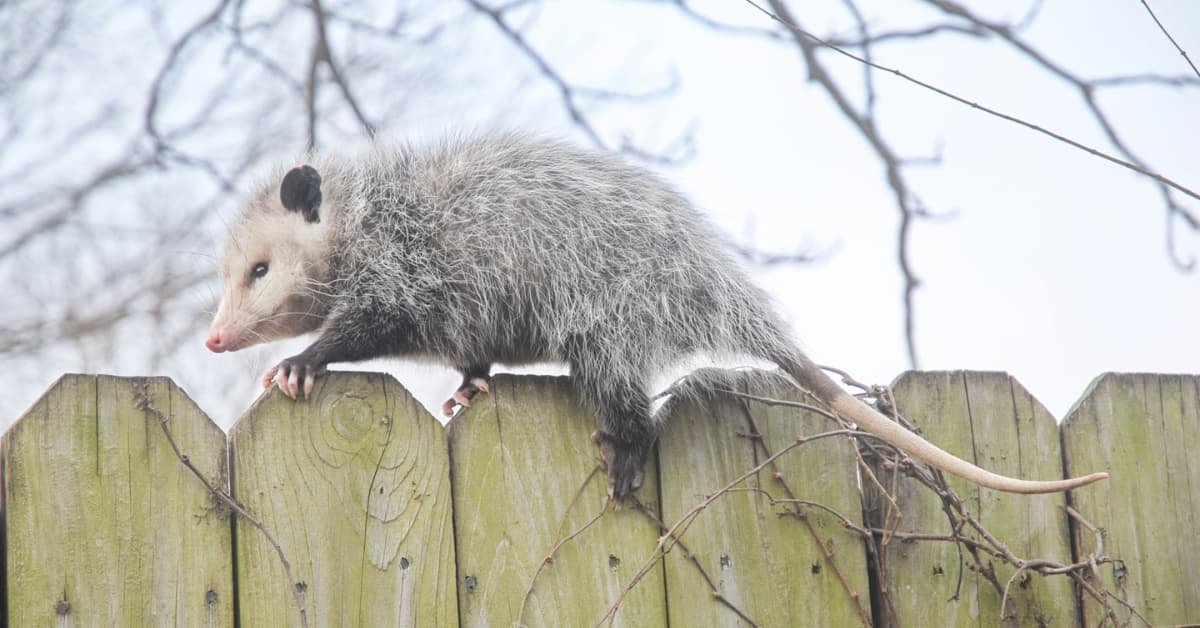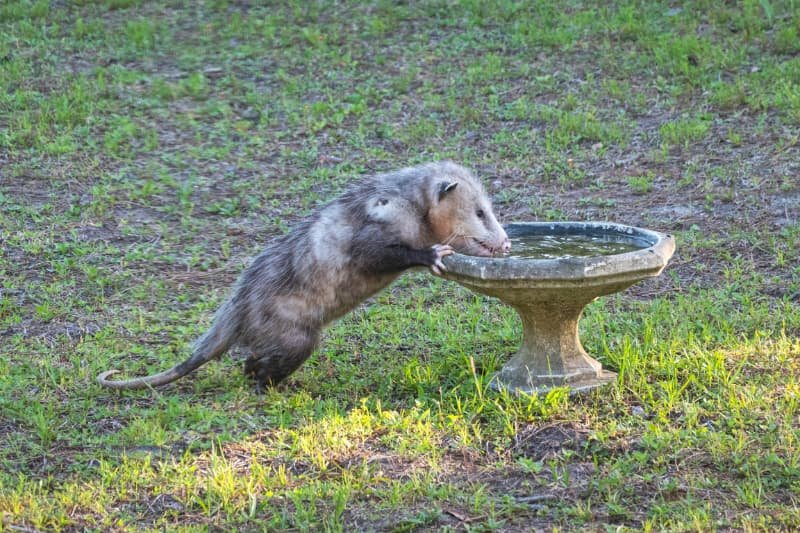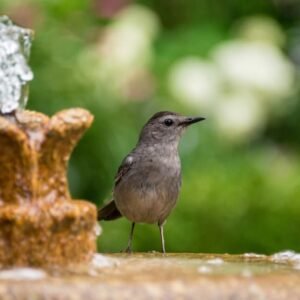
Possums, also known as opossums, are a common sight in many suburban and rural areas of North America.
These nocturnal creatures are known for their scavenging habits and ability to infiltrate yards, causing damage to gardens, trash cans, and even pet food.
However, with some knowledge and effective solutions, it is possible to protect your yard from possums.
We will explore “Can possums climb fences”, their habits, and behaviors, and provide practical solutions to protect your yard from their nocturnal prowling.
Short Summary
- Possums can climb fences due to their long claws, thumbs, and strong feet, as well as their prehensile tail for grabbing and stabilizing.
- To keep possums out of your yard, it is important to cut off their food supplies and hiding spots, such as storing garbage cans and pet food in sealable containers, taking down bird feeders, and thinning out thick hedges and vegetation.
- Using extra yard lighting and stinky deterrents like mothballs, dog urine, and blood meal can also help keep possums away.
- By reducing options for shelter, such as removing equipment that can shelter a possum, they will likely move elsewhere.
Possum Behavior and Habits
Possums’ nocturnal behavior and preference for moist areas make them more likely to set up habitats in yards with hiding spots and accessible food sources.
These marsupials are known for their climbing abilities, thanks to their long claws, thumbs, and strong feet.
They also have a prehensile tail that they use for grabbing and stabilizing as they climb.
Despite being seen as pests by some, possums can be beneficial to have in a yard. Studies have shown that they can consume up to 5,000 ticks in a season, which helps control tick populations.
However, to deter possums from setting up habitats in a yard, it’s important to eliminate potential hiding spots and food sources.
This includes storing garbage cans and pet food in sealable containers, taking down bird feeders, and thinning out thick vegetation.
By understanding possum habitat preferences and behaviors, homeowners can take steps to protect their yards while also promoting conservation efforts.
Signs of Possums in Yard
Indications of the presence of possums in residential spaces may include scratches on surfaces, an unpleasant odor, missing pet food, and materials used to construct nests.
Possums are nocturnal animals and are more active during the night. They are also attracted to areas with a food source and easy access to water.
Possums are known for their ability to climb fences and trees due to their long claws, thumbs, and strong feet.
They also have a prehensile tail that they use for grabbing and stabilizing themselves.
To keep possums out of a residential yard, it is important to cut off their sources of food and hiding spots.
This includes storing garbage cans and pet food in sealable containers, taking down bird feeders, and putting away any equipment that can shelter a possum.
Additionally, thinning out thick hedges and vegetation and using extra yard lighting can also help deter possums.
Certain scents such as mothballs, dog urine, and blood meal can also be used to stink out possums, as they have sensitive senses of smell and will avoid areas with predator smells. By reducing options for shelter, possums will likely move elsewhere.
Preventing Possums in Yard

One way to deter possums from visiting residential spaces is by reducing food sources and shelter, as 32% of possums’ diet consists of human refuse.
Natural deterrents such as mothballs, dog urine, and blood meal can be used to stink out possums.
These substances contain chemicals that repel possums due to their sensitive sense of smell.
Additionally, reducing options for shelter can encourage possums to move elsewhere.
Thinning out thick hedges and vegetation, as well as using extra yard lighting, can help eliminate hiding spots for possums.
In cases where natural deterrents and reducing shelter options are not effective, professional pest control services may be necessary.
These services can provide a long-term solution by identifying and addressing the root cause of the possum infestation.
They may also offer preventive measures to ensure that the possums do not return in the future.
Overall, implementing natural deterrents and reducing shelter options can be an effective way to prevent possums from infiltrating residential yards.
However, in cases where these methods are not effective, it is recommended to seek professional pest control services.
Effective Solutions
Implementing natural deterrents and reducing shelter options are effective methods to prevent possums from infiltrating residential areas.
Fences can be protected by adding a layer of smooth metal or plastic to prevent easy gripping and climbing.
Additionally, natural repellents such as predator urine, peppermint oil, and garlic can be placed around the perimeter of the yard to discourage possums from entering.
However, it is important to note that these repellents may also deter other animals, including beneficial ones. Therefore, it is recommended to use them sparingly and strategically.
Reducing shelter options is another effective method to discourage possums from setting up habitats in residential areas.
Thick hedges and vegetation should be thinned out to make them less attractive for nesting.
Additionally, removing piles of debris, brush, and logs can eliminate hiding spots for possums.
By reducing the availability of shelter, possums are more likely to move elsewhere.
Overall, implementing natural deterrents and reducing shelter options can help to protect yards from possums without resorting to harmful methods.
FAQs:
Can possums transmit diseases to humans or pets?
Possums can transmit diseases such as leptospirosis, tularemia, and salmonella to humans and pets through contact with their feces, urine, or saliva. Prevention measures include avoiding contact with possums and their habitats, wearing gloves when handling potentially contaminated materials, and washing hands thoroughly.
How do possums compare to other common backyard pests, such as raccoons and squirrels?
Comparing backyard pests, possums, raccoons, and squirrels have different behaviors and tendencies. Possums are nocturnal, attracted to moist areas, and climb fences with their long claws and prehensile tail. Understanding these differences can aid in effective pest management and conservation efforts.
Are there any specific plants or landscaping features that possums are attracted to or repelled by?
Possums are attracted to moist areas and food sources like trash cans and compost heaps, but they are not particularly drawn to specific plants or landscaping features. Repellent techniques such as mothballs, predator smells, and limiting hiding spots can be effective.
What is the lifespan of a possum, and how many offspring do they typically have?
Possums typically have a lifespan of 2-4 years in the wild and can have up to 20 offspring in their lifetime. They are opportunistic omnivores who thrive in a variety of habitats, including forests, grasslands, and suburban areas. Possums have adapted to survive in the wild by being nocturnal and using their prehensile tails to aid in climbing and gripping. Understanding possum biology and behavior is crucial for effective conservation efforts.
Are there any humane methods for removing possums from a yard, or is trapping and relocation the only option?
Natural deterrents such as predator smells and bright lighting can be effective in deterring possums from yards. Ethical considerations should be taken when removing possums, such as ensuring their safety and avoiding harm to other wildlife.



